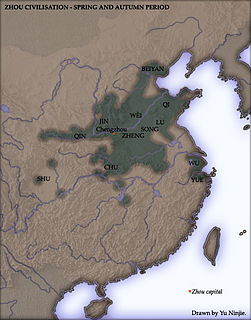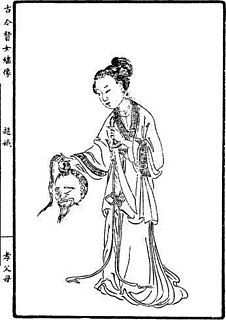Related Research Articles
King Xiang of Zhou, personal name Ji Zheng, was the eighteenth king of the Chinese Zhou Dynasty and the sixth of the Eastern Zhou. He was a successor of his father King Hui of Zhou.

Jin, originally known as Tang (唐), was a major state during the middle part of the Zhou dynasty, based near the centre of what was then China, on the lands attributed to the legendary Xia dynasty: the southern part of modern Shanxi. Although it grew in power during the Spring and Autumn period, its aristocratic structure saw it break apart when the duke lost power to his nobles. In 403 BC, Jin was split into three successor states: Han, Zhao and Wei. The Partition of Jin marks the end of the Spring and Autumn Period and the beginning of the Warring States period.
Duke Mu of Qin, born Renhao, was a duke of Qin in the western reaches of the Zhou Kingdom during the Spring and Autumn Period of Chinese history. Sometimes considered one of China's Five Hegemons, he greatly expanded the territory of Qin during the reign of King Xiang. He was also known for his many talented advisors, such as Baili Xi, Jian Shu (蹇叔), Pi Bao (丕豹), and Gong Sun (公孫).
Emperor Xiaowu of Jin, personal name Sima Yao (司馬曜), courtesy name Changming (昌明), was an emperor of the Eastern Jin Dynasty (266–420) in China. During his reign, Jin saw his dynasty survive a major attempt by Former Qin to destroy it, but he would nevertheless be the last Jin emperor to actually exercise imperial power, as his sons Emperor An and Emperor Gong would be controlled by regents and warlords. Emperor Xiaowu died an unusual death—he was killed by his concubine Honoured Lady Zhang after he insulted her.

Duke Wen of Jin, born Chong'er, was a scion of the royal house of Jin during the Spring and Autumn Period of Chinese history. He famously endured a long period of exile from his realm before finally being restored to power and rapidly leading Jin to hegemony over the other Chinese states of his time. He is a figure in numerous Chinese legends, including those about his loyal courtier Jie Zhitui, whose death is said to have inspired China's Cold Food and Qingming Festivals.
Zhang Yan, known formally as Empress Xiaohui (孝惠皇后) was an empress during the Han Dynasty. She was the daughter of Princess Yuan of Lu and her husband Zhang Ao, the Prince of Zhao and later Marquess of Xuanping.
Empress Wu, personal name Wu Xian, formally known as Empress Mu, was an empress of the state of Shu Han during the Three Kingdoms period. She was the last wife and the only empress of Liu Bei, the founding emperor of Shu Han, and a younger sister of Wu Yi.
Jia Chong (217–282), courtesy name Gonglü, was a Chinese politician who lived during the late Three Kingdoms period and early Jin dynasty of China. He started his career as an advisor to Sima Shi and Sima Zhao, the regents of the state of Cao Wei in the Three Kingdoms era, and subsequently served as an official in the court of Sima Zhao's son, Sima Yan, after the establishment of the Jin dynasty.
Liu Cong, courtesy name Xuanming, nickname Zai, formally Emperor Zhaowu of Han (Zhao), was an emperor of the Xiongnu-led Chinese Han Zhao dynasty. He captured the Emperor Huai of Jin and the Emperor Min of Jin, and executed them back in Pingyang after forcing them to act as cupbearers. These raids finally forced the Jin dynasty to move their capital from Luoyang to Nanjing.
Liang was a traditional Chinese fief centered on present-day Kaifeng. It was held by various powers over the course of Chinese history. It generally comprised modern Henan with a small part of Shanxi.
Duke Xian of Jin, ancestral name Ji (姬), given name Guizhu (詭諸), was the nineteenth ruler of the State of Jin. He was also the ninth ruler of Jin in the Spring and Autumn period and the second duke of Jin. When his father, Duke Wu of Jin, died in 677 BC, Guizhu ascended the throne of Jin and became Duke Xian of Jin. He reigned for 26 years. He moved the capital from Quwo (曲沃) to Jiang (絳). He was named after a Rongdi tribe (戎狄族) leader Guizhu (詭諸) whom his father, Duke Wu of Jin, captured alive.
Li Ji was a concubine and later wife of Duke Xian of Jin, ruler of the State of Jin between 676 and 651 BC during the Spring and Autumn period of ancient China. Li Ji is best known for starting the Li Ji Unrest which led to the suicide of Prince Shensheng. She also placed her own son Xiqi on the Jin throne after the death of Duke Xian. She was nicknamed as the "Witch of the Age" because of her devious acts.
Duke Hui of Jin, born Yiwu, was the duke of Jin during the Spring and Autumn Period of China's Zhou dynasty.
Duke Huai of Jin, personal name Yu, was briefly the duke of Jin during the Spring and Autumn period of the Zhou dynasty.
Duke Ling of Jin was from 620 to 607 BC the ruler of the State of Jin, a major power during the Spring and Autumn period of ancient China. His ancestral name was Ji, given name Yigao, and Duke Ling was his posthumous title. When his father Duke Xiang of Jin died in 621 BC Yigao was still a young boy. He ascended the throne with the support of his regent Zhao Dun (趙盾).
Duke Wen of Qi was from 815 to 804 BC the tenth recorded ruler of the State of Qi during the Western Zhou Dynasty of ancient China. His personal name was Lü Chi (呂赤), ancestral name Jiang, and Duke Wen was his posthumous title.

Hu Yan was a Di tribesman who served as a minister and general of Jin during the Spring and Autumn Period of Chinese history. Hu Yan assisted Prince Chong'er during his long exile, his usurpation of his nephew Yu, and his rise to hegemonic status over the other states of the Zhou Kingdom. The Legalist Han Fei considered Hu Yan one of the best advisors of ancient China, and the historian Sima Qian listed him with Sun Tzu as the greatest tacticians of the age.

Pang E (龐娥) or Zhao E (趙娥) was a Chinese noble woman from the Later Han to the Three Kingdoms period. Born in Gansu province, she was the mother of the Cao Wei politician, Pang Yu. She murdered her family's killer before turning herself in. Her case was recorded in Huangfu's Biographies of Exemplary Women (列女傳) which was supposed to be an instructional text for Confucian women. Due to her act of extreme bravery, she was immortalized as one of the memorable acts of courage and virtue performed by a woman in Chinese history. Zhao E was famous as one of the heroines depicted in the Wu Shuang Pu by Jin Guliang.

Nanzi (南子) also called Wey Ling Nanzi was the consort of Duke Ling of Wey in the Spring and Autumn period. She was most famous for her meeting with Confucius in 496 BC. She was de facto ruler of Wey in the place of her spouse, who was disinterested in politics.
Guo Huai, courtesy name Yuhuang (玉璜) or Yuanshao, was a niece of the general Guo Huai, the second wife of Jia Chong, the mother of Jia Nanfeng, and the mother-in-law of Emperor Hui of Jin. During her life she also went by Lady of Guangcheng (廣城君) and Lady of Yicheng (宜城君). After her death she received the posthumous name Xuan (宣).
References
- 1 2 3 Lily Xiao Hong Lee, A. D. Stefanowska, Sue Wiles. Biographical Dictionary of Chinese Women: Antiquity through Sui, 1600 B.C.E. - 618 C.E. at Google Books 2007.